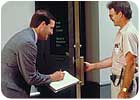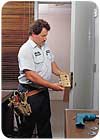
Working with a customer is the best way to determine the mechanical access control and video surveillance needs of a facility.
Although each job is different and cookie-cutter approaches are discouraged by security dealers and systems integrators, it is possible to create a general list of questions or a template of issues that need to be discussed with customers when designing and installing a job that integrates access control and video surveillance equipment. Finding out specifically what an end user wants — through an actual list of questions or just a mental checklist — can help close a deal, and make for a more satisfied customer.
Some dealer/integrators recommend not discussing technical issues with customers but just determining what it is they want their system to do. Then the system can be designed to meet their needs.
“We don’t really have a standard template approach questionnaire-wise that the sales force follows,” declares Bill Fitz-henry, vice president of U.S. field sales for HSM Electronic Protection Services Inc., Lisle, Ill. “We spend more time directly with the end user understanding their problems and applications so we can provide in a direct relationship with them proposals and design solutions to that problem. It helps provide us with a competitive advantage.”
“The idea is to figure out what the customer really needs,” emphasizes Scott Higinbotham, training manager for Stanley Security Solutions Inc., Indianapolis. “It’s hard to come up with a specific template. If you start with enough concepts and areas of discovery, use that as a guide.”
John Hyatt, national system sales manager for Tri-Ed Distribution Inc., Woodbury, N.Y., recommends that dealers beware of out-of-date specifications that an architect or engineer may pull out of an old file. “The a&e may not be up on security,” he says of architects and engineers. “If you can get to the end user, that’s where you need to go.”
Customers knowing what they want can be good or bad, points out Bryan McLane, systems design, The Systems Depot, Hildebran, N.C. “It depends on how set they are in their ways,” he emphasizes.
Gene Samburg, president of Kastle Systems Inc., Arlington, Va., agrees that each job is different, but his company does use a proprietary checklist.
“We have a checklist that helps us determine what is the functionality the client is trying to accomplish, and from that we build,” Samburg explains. “We ask them all the questions — who is coming, when, where do you want them to go. We have it for access, but video is an adjunct. The hard part is the access.”
Eric Elsenbroek, systems support manager for ADI, Louisville, Ky., says a list of questions can be helpful. “It has to do with the knowledge of the dealer, talking to the end user, taking him down a line of questions and doing his own discovery,” Elsenbroek explains. “All of the specialists at ADI use this same line of questioning to provide consistency in the pre-sale application process. We like to call it our recipe for success. We try to stick with the same recipe.”
The following list of questions is designed to suggest starting points for discussion with end users on what they want their systems to do.
Here is a helpful list of questions that security dealers and systems integrators can take into a sales or proposal meeting for a video/access integration project with a prospective customer.
Project Questions
- What is the projected time line of the project?
- How many buildings or locations are involved in the project, and does the client plan on expanding the system in the future?
- What time zones are they in?
- Are there any hazardous areas with chemicals or other substances in the client’s facility that require special access or video requirements?
- What training will the client’s staff require to operate or maintain the security system?
- Is remote viewing of video and/or remote control of cameras or access required?

The type of lock must be specified when designing an access system. Sometimes, existing locks must be replaced.
Integration Questions
- Is electrical or contact closure-based integration available or actual communication between the access and video systems required?
- What type of access control event will trigger a camera?
- What should the camera be programmed to do in the event of an access control event?
- What alarms should trigger a notification, and who should be notified?
- What should happen when the system receives an alarm? Should the event be recorded, the doors opened (if a fire), the doors locked down (if a burglary or emergency) or something else?
- Should video of the person attempting entrance be shown or recorded when a valid access read is received? Or only when an access attempt is denied?
- Should the ID picture be displayed for a guard to verify visually?
- Will the client want the same card to access both doors and PCs for logical and physical security?
- Will the system be remotely monitored — access, video or both?
- Does the client want one graphical user interface (GUI) to control all the systems?
- Does the manufacturer support the software most appropriate for the customer’s needs?
- Does the customer already have access control software? Video surveillance software? If so, are they compatible?
- Will the access and DVR manufacturers create an SDK that is not yet available if it is necessary?
- Does an existing DVR or the access control system have to be upgraded?
- Is there going to be a matrix involved?
Access Questions
- How many doors and how many readers will be used in the job?
- How many of which type? Proximity, keypads, biometric, smart cards, photo IDs?
- How many employees will use the system?
- What are the employees’ work schedules?
- What type of reporting functions does the customer need?
- Is an audit trail required? Is video needed to back up the access event?
- Does the client want just to restrict access or track employee and visitor movements?
- Is a telephone entry system required? Are turnstiles required?
- If the client has multiple locations, is a single credential for access to all facilities desired?
- Are anti-passback readers needed on both sides of any doors?
- How many cards will be needed for this application? Does the client want keyfobs or other devices instead of cards?
- Do employees and/or visitors need photo ID badges?

The type of door frame and door material are important considerations in the design and installation of an access system.
Door
- What is the door’s function? (employee, visitor, fire exit?)
- What type of door is it? (single, double, inswing, outswing, turnstile?)
- What is the normal position of each door? (open or closed?)
- What material is each door and door frame made of?
- When is each door secure? (Always, nights, weekends?)
- What are the fire regulations on the doors?
- Are any fire-rated doors and frames used? Can the door frame be altered without losing the fire rating?
- What existing hardware is on each door?
- What door contact is on each door or is required for each door?
- What type of request-to-exit sensor or button is required for each door?
- What are the reader mounting options for each door?
- What will release the lock from the inside?
- Is release momentary or maintained? (If momentary, is a relock delay required by code?)
- Will there be any indicators on the doors? Color? Indication? (Locked, unlocked?)
- Audible indicators? Indication? (door propped, etc.)
- What will trigger an audible alarm? (Door position switch, lock status?)
- What will reset an alarm? (key switch, door position switch?)
- Should the fire alarm system release the lock?
- Provide a sample description of the operation of each type of door.
- Is the opening fire-labeled? (This affects the use of fail-safe or fail-secure devices.)
- Is the opening a designated egress?
- Is it a high security area? Or for traffic control? Fail-safe or fail-secure?
- Should electric strikes, electromagnetic locks or electrified locksets be used?
- What is the mounting type for the lock? (standard, concealed, top jamb?)
- What finish is required for the door hardware?
- Will the access system be hardwired? Remote location with dial-up? Networked through TCP/IP?
- How many clients do you need for TCP/IP?
- Is the opening a designated egress?
- Do any egress requirements of the Americans With Disabilities Act (ADA) apply? (restricted, unrestricted, automatic?)
- Any ADA requirements for access? (key, keypad, card reader, etc.)
- Does the ADA require any visual LEDs? Audibles? On-site? Remote? Condition to be monitored?
- Is access to be controlled to any outdoor facilities, such as a parking lot or equipment building?
- Are gates required to access the facility?
- What type of fire, intrusion and video monitoring is needed? A central station? An on-site control room?
- Is any enhanced, audio or video verification required by the AHJ?
Wiring
- Are any readers farther than 500 feet from the controller?
- Is it a plenum or nonplenum environment?
- Where are the power supplies located and what surge protection is needed?
- What gauge of wire is needed to bring power to the control panels and readers?
- Is back-up power needed or is battery back-up required?
- What is the voltage of the system? (12 or 24 VAC or VDC?)
- What is the maximum current draw of all loads in the system?
- What options are with the system? (Relock output, time-delay, fire panel interface?)
- Is a specific point-to-point wiring diagram required? Are the wiring diagrams provided with the equipment sufficient?
Video Questions
- What information do you want to obtain from the video surveillance equipment?
- Is analog or IP video to be used?
- How crucial is remote viewing and control capability?
- How many laptops will be outfitted with the licensed software to provide remote viewing?
- What is the client’s network infrastructure?
- Is high-speed Internet access already installed throughout the facility?

Seeing video equipment being demonstrated can help narrow down choices for customers.
Cameras
- What do you want the cameras to see and what is the distance?
- What type of lenses are needed? Wide-angle, normal, telephoto? Can varifocal lenses be used?
- What resolution is needed for each camera?
- Are megapixel, high-resolution cameras needed?
- Are licenses required for the digital cameras?
- How many images per second are needed for each camera?
- What is the total number of cameras required? Fixed or pan-tilt-zoom (PTZ)?
- What type of cameras are needed: dome cameras? Bullet cameras? Enclosures? PTZs? Wall or ceiling mount?
- If PTZ cameras are needed, are operators available, or will the PTZs be set on an automated panning pattern? Or will the PTZs be digital so they can be zoomed or moved after a recording is made?
- Are cameras in a special environment requiring enclosures, such as explosion-proof housings?
- What type of ceiling and walls are available? (dropped ceiling, hard ceiling and walls, drywall?)
- Are cameras needed outside?
Outdoor Cameras
- What areas do you want to cover outside? (entrances, parking lots?)
- Do license plate numbers have to be read?
- Is there any illumination at night? Are infrared illuminators needed? Day/night cameras?
- Are dome cameras appropriate or enclosures for cameras?
- Are heaters or blowers needed due to weather conditions?
- Is conduit available for wires or should outside-rated wiring be used?
Wiring, Power
- What gauge of wire is needed to bring power to the cameras? (plenum or non-plenum?)
- What type of wire is needed from the cameras: coax, twisted pair, Cat 5e, fiber-optic? Is it already installed?
- Would you homerun each fiber-optic cable to a camera or attach it to an IP network?
- What type of connectors are needed for the camera cable: BNC, two-piece, three-piece, crimp, compression fit?
- Can power over Ethernet (PoE) be used?
- Where are the power supplies located?
- What surge protection is needed? Is back-up power needed?
Video Requirements
- How long does the client need to store the video? Where can storage be located?
- How many weeks of video need to be stored?
- Can the DVR or NVR handle the storage requirements or are additional servers required?
- Does the client want redundancy or RAID backup?
- Are any other specialty devices required, such as a joystick for operator control of PTZ functions?
- What type of DVR will be used: hybrid, NVR? How many?
- Does the client have to view recorded and live video side-by-side?
- What are the search requirements: by date, time, object, person, location?
- Do events have to be found in the access record, video record or both?